F. W. Hampshire
F. W. Hampshire & Co. was founded by Frederick William Hampshire in Derby in 1895. I know next to nothing about Frederick’s background except that he was born in Ossett, West Yorkshire to Matthew William Hampshire [1839-1912] and Esther Hampshire [1837-1882} née Moody.
The business Frederick founded prospered and he moved its operations to a new site at the Silk Mill Works, Derby in 1908.
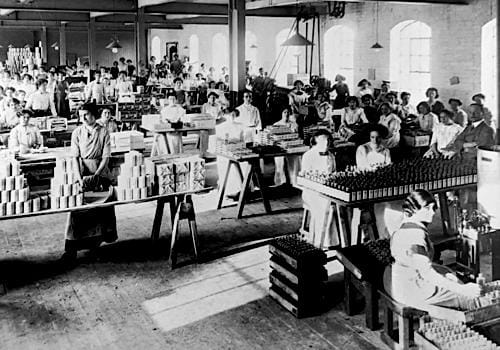
Above: 1908 Workers at the Old Silk Mill (Silk Works) on the Derwent River in Derby. The factory burnt down in 1910 but F. W. Hampshire rebuilt as the Riverside Works. The company opened a second factory in Abbey Street, Ilkeston in 1911 and another in Mosley Street, Burton in 1914. In the 1920s, the Ilkeston and Burton plants were replaced by a factory in George Street, Riddings.
F. W. Hampshire & Co. became a private limited liability company, F. W. Hampshire & Co., Ltd. (capital £15,000), in 1915 and then a public limited liability company, F. W. Hampshire & Co., (1927) Ltd. (capital £155,000), in 1927.
The prospectus for F. W. Hampshire & Co., (1927) Ltd. lists a wide variety of products produced by the company across its two factories. The head factory at the Riverside Works, Derby manufactured products such as Egrol Custard Powder, Creamilla and Devonshire Ice Cream Powders, Luxona Gravy Granules, Jellova Jellies, Selzo Liver Salts Cough mixtures and other medicinals while Palmosa and other Toilet Soaps, Wasp Fly Bands, Fly Sprays and Snowfire Toilet Preparations were produced at a branch Globe Works factory in Riddings, Derbyshire. Of these, it is only the Snowfire Toilet Preparations that are of interest to me.
Snowfire
The origins of the Snowfire range is a bit of a mystery. Rather than toiletries it appears to have begun with two medicinals – Snowfire Tablet, and Snowfire Powder – which were used treat chaps and chilblains. In addition, the range does not appear to have begun with F. W. Hampshire but rather A. L. Laing, a Scottish manufacturing chemist who operated a pharmacy in Lerwick, Shetland.
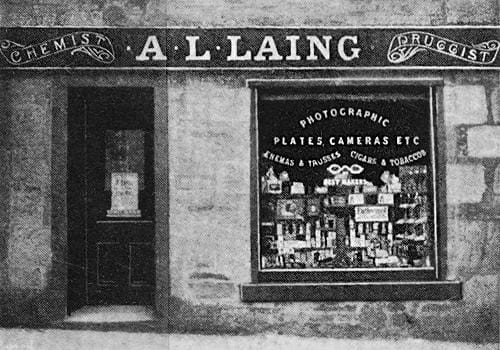
Above: c.1914 A. L. Laing (Market Cross Pharmacy) on Commercial Street, Lerwick established by Arthur Laurenson Laing [1858-1942]. It opened in 1888 and remained there under various owners until 2017 when it moved to Kantersted Road, Sound and became Laing’s Pharmacy.
Snowfire Powders and Tablets were advertised by A. L. Laing in 1911 and 1912 with F. W. Hampshire doing the same from 1914 but with an additional product Snowfire Vanishing Cream also described as a skin protectant. I don’t have any records of A. L. Laing selling the Snowfire lines to F. W. Hampshire but the advertising suggests that F. W. Hampshire bought Snowfire rather than developing it in-house.
Snowfire Tablet: “For chapped hands, roughness & redness of the skin, cracked lips, frostbites etc.”
Snowfire Powder: “After a few doses the irritation ceases and healthy skin takes the place of the inflamed substance. Snowfire Powders remove the cause of chilblains and thus effect a sure cure.”
Snowfire Vanishing Cream: “For chapped hands, roughness & redness of the skin. Makes the skin soft & white.”
During the First World War, F. W. Hampshire advertised using Snowfire Tablets to protect the hands and feet of troops on the front from the biting winter cold and to preserve the hands of munitions workers, many of whom were women and Snowfire became a widely recognised brand.
Although women now engage in rough, grimy work, they pay more attention to well-kept hands. Snowfire sells briskly because it instantly cleanses the pores from dirt, softens and whitens the skin. Used also for Chapped Hands, Cracked Lips, Redness and Roughness of the Skin.
(Snowfire advertisement, 1918)
After trademarking the Snowfire name in 1917, F. W Hampshire expanded the range starting with Snowfire Soap in 1923, followed by Snowfire Jelly, Snowfire Face Powder, Snowfire Shampoo, Snowfire Talcum Powder, and Snowfire Shaving Stick in 1925, and Snowfire Ointment later in the decade.
Snowfire Soap: “[T]he soap that soothes and keeps the skin soft and healthy.”
Snowfire Jelly: “[A] softer form of the popular Tablet, packed in dainty aluminium containers which make it very convenient to handle and apply.”
Snowfire Face Powder: “This finest of silk-sifted powders gives your skin new loveliness. It goes on so smoothly. It stays on for an extra long time. It prevents large pores and a coarsened texture.” Shades: Naturelle, Rachelle, and Peach, with Deep Rachelle, and Suntan added by 1935 and Golden Peach by 1939.
Snowfire Ointment: “[A]ntiseptic and healing.”
See also: Vanishing Creams
In 1924, F. W. Hampshire also repackaged the Snowfire Vanishing Cream in a more attractive jar and added a version that could be more easily carried in a purse. Both changes clearly directed at women.
Some of the additional capital raised from the float of F. W. Hampshire & Co., (1927) Ltd. on the stock exchange was used to build the new Sunnydale Works factory at Sinfin Lane, Derby in 1928.
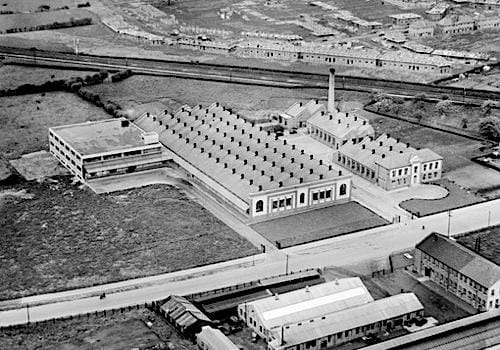
Above: 1932 The F. W. Hampshire factory on Sinfin Lane, Derby.
The company also began expanding overseas, developing agencies in India, Australia, Canada, and America by the end of the decade. The economic downturn of the 1930s would see the agencies in India and America closed down and the Australian and Canadian agencies went the same way when the Second World War broke out in 1939.
1930s
The decade began with a marketing mistake. It would appear that the company wanted to introduce a glycerine jelly into the Snowfire range. To avoid confusion with the older Snowfire Jelly, F. W. Hampshire decided to rename it as Snowfire Visil and announce that they would do so in 1929. They rapidly backtracked from this decision and after Snowfire Glycerine Jelly was introduced in 1931 the older Glycerin Jelly (Visil) became Soft Snowfire.
Snowfire Glycerin Jelly (Vanishing): “Use it every time you wash—it prevents all redness and roughness. Use it while you’re cooking—it’s cool and soothing and absorbed in a minute. Use it regularly and your hands will quickly become white and smooth—stay lovely always.”
F. W. Hampshire updated the product packaging for the Snowfire range a few times during the 1930s. In the early 1930s the older purse containers were replaced with tins decorated with a picture of a dancing woman in the Arte Deco style. Very few of these appear to have survived. In 1935, these were replaced with more sober designs with geometric patterns combined with a silhouetted woman’s face in profile.
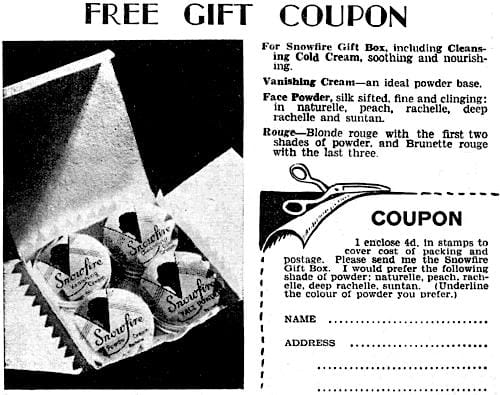
Above: 1935 Free gift coupon for a Snowfire Gift Box containing Snowfire Cleansing cold Cream, Vanishing Cream, Face Powder, and Rouge in new packaging. These were full sizes not samples.
By the time F. W Hampshire introduced these new designs in 1935 the company was advertising additional items in the Snowfire range including Snowfire Powder Cream, Snowfire Rouge, Snowfire Blush Cream; Snowfire Cleansing Cold Cream, and Snowfire Cleansing Milk. Unfortunately, I do not have firm release dates for these products.
Snowfire Blush Cream came in the same shades as Snowfire Rouge but was packaged in a tube rather than a tin.
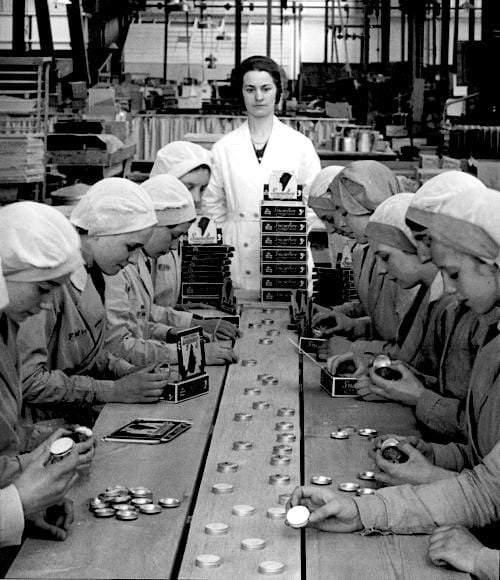
Above: Packing what looks to be tins of Snowfire Powder Cream probably in the late 1930s.
Snowfire Powder Cream: “Banish shiny nose forever. Keep your skin ‘matt’ and lovely.” Known shades: Naturelle, Rachelle, Peach with Deep Rachelle, Ivory and Sun-Tan.
Snowfire Rouge: “[G]ive your cheeks colour that looks absolutely natural.” Known shades: Blonde, Brunette, with Tangerine added in 1935, and Medium in 1938 which became Rose-Brunette in 1939.
Snowfire Blush Cream: “[N]obody can tell that it is not your own colour! Because it'’s a cream it goes on more evenly and can’t cause ugly open pores. Because you put it on under your powder, it stays on far longer.” Shades: Blonde, Brunette, and Tangerine, with Medium added in 1938 which became Rose-Brunette in 1939.
Late in 1935, F. W. Hampshire added Snowfire Shampoos in two tints – Henna for dark hair and Camomile for fair hair. Both were sold as a powder that had to be mixed before use. By 1938, Snowfire Wave Set, a hair setting lotion, had also been added to the series.
Snowfire Shampoos (Henna and Camomile): &ldquo[Q]uickly give your hair a lovely silkiness and gloss because they stimulate it and give it new health. They banish ugly dandruff, scurf and greasiness.”
Snowfire Wave Set: “[T]he marvellous setting lotion that holds your set in place until you wash it out.”
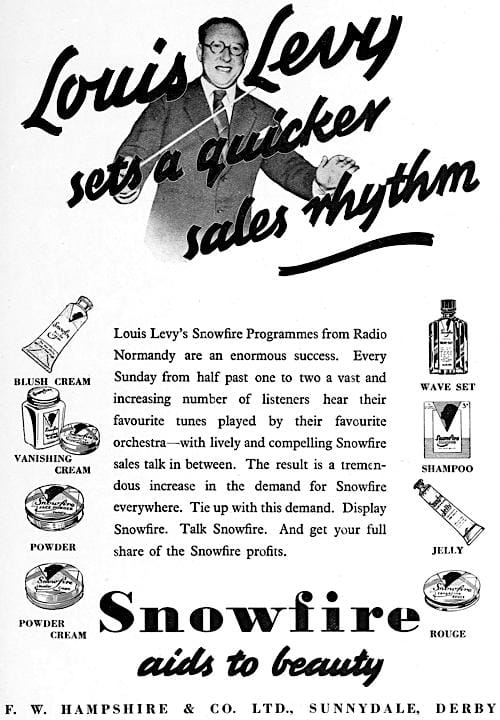
Above: 1938 Trade advertisment for Snowfire aids to beauty radio program promoted though Radio Normandy.
It appears likely that F. W. Hampshire added other Snowfire cosmetics before the Second World War broke out in September, 1939. Unfortunately, the only ones that I have been able to identify are Snowfire Lipstick, an indelible in five shades, and Snowfire Powder Cake, a cake compact in four shades.
Snowfire Lipstick: “[S]tays on beautifully and smoothly.” Five shades.
Snowfire Powder Cake: “[A]ll you need is a little bit of damp sponge or cotton-wool and in ten seconds your complexion can have that cool matt finish that last for hours.” Shades: Naturelle, Rachelle, Peach, and Suntan.
In 1938, F. W. Hampshire introduced a Vitamin Skin Cream in a tube. Unfortunately, I have been unable to determine if it formed part of the Snowfire range. It seems likely that it was discontinued I have been unable to find any advertisements for the product. Also added in 1938 was a new form of Snowfire Tablet which now came in a push-up stick and Dewies Facial Refresher Pads which came in two forms, one for dry skin the other for skins that are oily.
Dewie Facial Refresher Pad: “[W]hisk away dust and make-up—cool and refresh your skin—close even the largest pores—give you a brand-new base for powder. It’s done in a flash. You’re ready for make-up again—clean, calm and collected.”
War
F. W. Hampshire continued to heavily advertise the Snowfire cosmetics range in the early years of the war. However, this dropped off considerably after 1940 with the company focusing more on promoting its Snowfire Tablets and Snowfire Ointment.
A major development for F. W. Hampshire during this time was its 1940 acquisition of Mrs. Pomeroy, a cosmetics brand that dated back to 1895. Pomeroy was a salon-based company, was more upmarket than Snowfire, and had a more extensive range.
See also: Mrs. Pomeroy
In 1943, F. W. Hampshire moved the Pomeroy salon to 174 New Bond Street and this also became the postal address for Snowfire cosmetics.
Post war
In 1947, F. W. Hampshire repackaged the complete Snowfire cosmetics range in a range of monotone colours patterned with a silhouetted head of a woman.
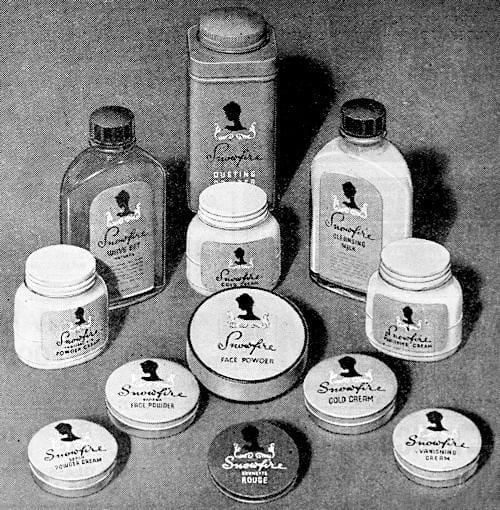
Above: 1948 Snowfire in new packaging.
The post-war Snowfire cosmetics range was outlined by F. W. Hampshire in a booklet released in 1950. In addition to some well established lines it included a number of items I have not previously come across.
See also: A Bride’s Beauty Secrets (c.1950)
Skin-care
Snowfire has a Cleansing Milk and Cold Cream in its range by 1935 at the latest. The Snowfire series may also have included a Toning Lotion before the war but I do not have any evidence for it before 1950. The three products gave Snowfire a standard cleansing and toning skin-care routine with women selecting the cleanser best suited to them or deciding to use all three.
Snowfire Cleansing Milk: “This fragrant, creamy lotion should be applied evenly with cotton wool—then wipe it off. You’ll be amazed when you see how much dirt is brought away.”
Snowfire Cold Cream: “Apply this soft cream generously to the skin and massage gently for a few minutes. wipe off the surplus cream.”
Snowfire Toning Lotion: “This is a gentle astringent to be patted on the skin after cleansing. You will find it refreshing, and it leaves your skin with a lovely smooth surface ready for your foundation and make-up.”
Make-up
Snowfire Vanishing Cream continued to be promoted as the main foundation for Snowfire Face Powder but women now had three other alternatives. As well as Snowfire Powder Cream, and Snowfire Powder Cake, F. W Hampshire had introduced Snowfire Matt Base in 1949. This was recommended particularly for dry skin types with Snowfire Powder Cake, which may have gone out of production during the war, now being suggested for normal or greasy skin types. I do not have post-war shade ranges for either the Matt Base of the Powder Cake but I would suggest that they same in the same shade ranges as Snowfire Face Powder and the Snowfire Powder Cream – Naturelle, Peach, Rachelle, Riviera, and Tropical Tan.
Snowfire Powder Cake: “For normal or greasy skin, this all-day foundation almost works a miracle!. It covers up little blemishes and gives a velvety finish that is most glamourous.”
Snowfire Matt Base: “This makes sure you complexion stays matt all day. It holds powder firmly and lends your skin a lovely colour tone that is truly flattering. It is especially good for dry skin.”
Other Snowfire make-up items included rouge and lipstick but I can find no evidence of any for of eye make-up.
Snowfire Rouge no longer appears in the Snowfire inventory with Snowfire Cream Rouge and the more recent Snowfire Cake Rouge both now only coming in two shades – Blonde, and Brunette. Snowfire Lipstick, which also may have gone out of production during the war was still only to be found in five shades – Chiffon Pink, fuschia, Satin Red, and Cabaret.
Hands
The older Snowfire Glycerine Cream had gradually become mainly advertised as a hand cream before the war. It appears to have continued on after the war as Snowfire Hand Jelly but F. W. Hampshire also added Snowfire Almond Hand Cream containing lanolin and almond oil.
Men’s range
F. W. Hampshire had added Snowfire Shaving Stick back in 1925 and it remained the only men’s product in the Snowfire until 1948 when the company introduced three brilliantines with chocolate on sandlewood labels decorated with a man-on-horseback motif.
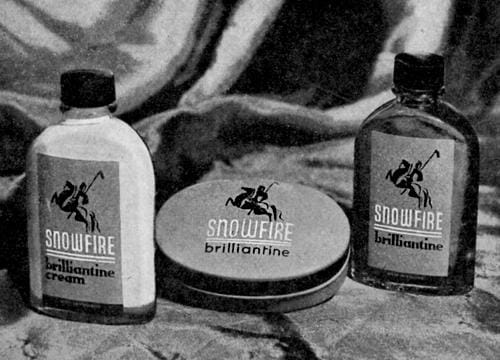
Above: 1948 Snowfire Cream Brilliantine, Solid Brilliantine, and Liquid Brilliantine.
The older Snowfire Shaving Stick, was restyled to match.
Other cosmetics
In 1951, F. W. Hampshire bought Maureen Baun, Ltd., a firm based in Bury Lancashire that made Lorelox and Toddilox hair products. F. W. Hampshire did have a Dusting Powder in its Snowfire range but Toddilox was the first cosmetic in its inventory that was specifically for children. In 1954, it added another — Snowfire Junior Baby Powder.
Other hair-care products added by F. W. Hampshire included Loxene Medicated Shampoo, and Lorelox Hair Styling lotion (1955), Safada Cream Shampoo (1957), and Tônrinz Hair Colour Rinse, and Camilatone Synthetic Henna Cream (1958), the last two gained through its purchase of the Camilatone, range in 1958. Additional hair-care products were added during the 1960s
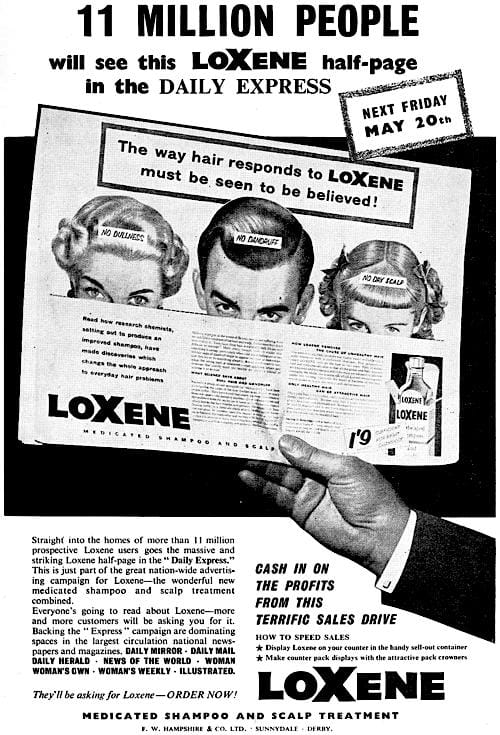
Above: 1955 Trade advertisment for Loxene Medicated Shampoo.
Another major addition was the Dor range of deodorants. This began Dor Stick Deodorant (1955) and Dor Spray Deodorant (1961). Like the hair-care products these were not part of the Snowfire range.
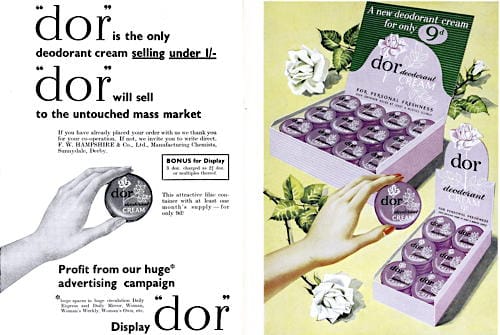
Above: 1954 Trade advertisment for Dor Cream Deodorant.
Later Developments
In 1948, F. W. Hampshire entered into an agreement with Reckitt & Sons, a subsidiary of Reckitt & Colman. The agreement created a new company, Sunnydale Products, Ltd. so that certain products produced by F. W. Hampshire could be distributed by the oversea organisation of Reckitt & Colman, Ltd. It should be remembered that F. W. Hampshire was still producing a wide variety of lines other than those mentioned including some newer lines like Zubes Cough Lozenges and Mixture, and Kwits Cough Lozenges.
Reckitt & Colman would go on to acquire F. W. Hampshire in 1965 but the Snowfire range had largely disappeared by then despite yet another packaging update in the 1950s. Only Snowfire Ointment Stick still appears to be available.
Timeline
| 1895 | F. W. Hampshire & Co. founded in Derby. |
| 1908 | Factory opened at the Silk Mill Works, Derby. |
| 1910 | Fire destroys the Silk Mill Works, Derby and it was rebuilt as the Riverside Works. |
| 1911 | Branch factory opened in Abbey Street, Ilkeston. |
| 1915 | F. W. Hampshire & Co., Ltd. founded in Derby. |
| 1923 | New Products: Snowfire Soap; and Snowfire Cream. |
| 1925 | New Products: Snowfire Jelly; Snowfire Face Powder; Snowfire Talcum; Snowfire Shampoo; and Snowfire Shaving Stick. |
| 1927 | F. W. Hampshire & Co., (1927) Ltd. established. |
| 1928 | Sunnydale Works factory constructed on Sinfin Lane, Derby. Riverside Works factory closed. |
| 1930 | Snowfire Jelly renamed as Snowfire Visil. |
| 1931 | New Products: Snowfire Glycerin Jelly. |
| 1937 | New Products: Snowfire Powder Cream; and Snowfire Blush Cream. |
| 1938 | New Products: Vitamin Skin Cream; and Dewie Facial Refresher Pad. |
| 1939 | New Products: Snowfire Powder Cake. |
| 1940 | F. W. Hampshire buys Mrs. Pomeroy. |
| 1947 | Snowfire range repackaged. |
| 1948 | Sunnydale Products, Ltd. created by F. W. Hampshire, and Reckitt & Sons. New Products: Snowfire Brilliantine, Solid Brilliantine, and Brilliantine Cream. |
| 1949 | New Products: Snowfire Matt Base. |
| 1951 | F. W. Hampshire buys Maureen Baun. |
| 1954 | Snowfire Hand Cream reformulated as Snowfire Almond Hand Cream. New Products: Snowfire Junior Baby Powder; and Dor Deodorant Cream. |
| 1955 | Globe Works factory in Riddings closed. New Products: Dor Deodorant Stick. |
| 1961 | Sunnydale Works factory expanded. New Products: Dor Deodorant Spray. |
| 1965 | F. W. Hampshire bought by Reckitt & Colman. |
First Posted: 21st November 2024
Sources
The American Perfumer & Essential Oil Review. (1906-1955). New York: Robbins Perfumer Co. [etc.].
The chemist and druggist. (1859-) London: Morgan Brothers.

Frederick William Hampshire [1863-1941]
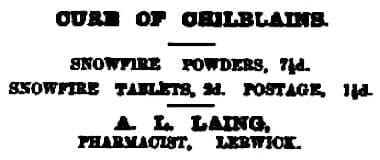
1911 A. L. Laing Snowfire Powders and Tablets.
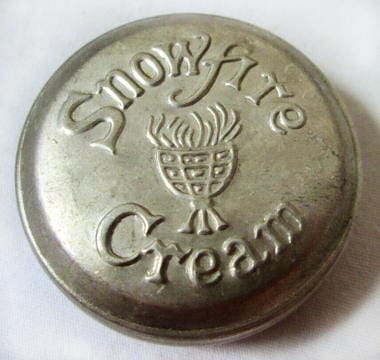
Early aluminium Snowfire (Vanishing) Cream purse container.

1915 F. W. Hampshire Snowfire Powders and Tablets.
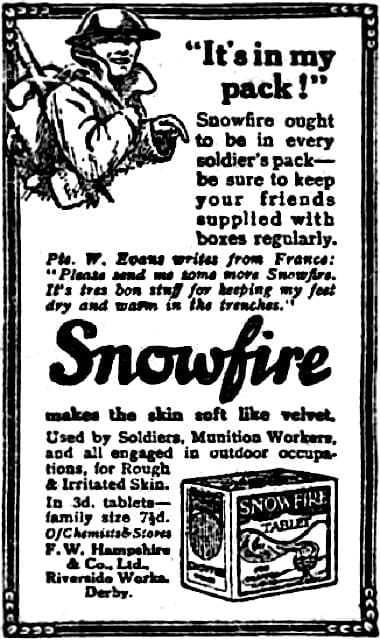
1918 Snowfire Tablets.
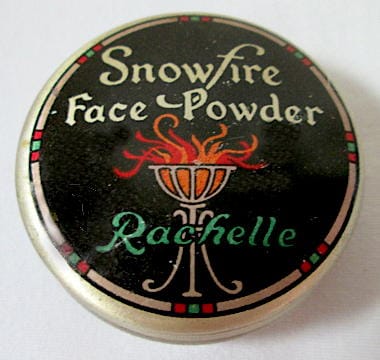
Early Snowfire Face Powder.

1924 Snowfire (Vanishing) Cream.
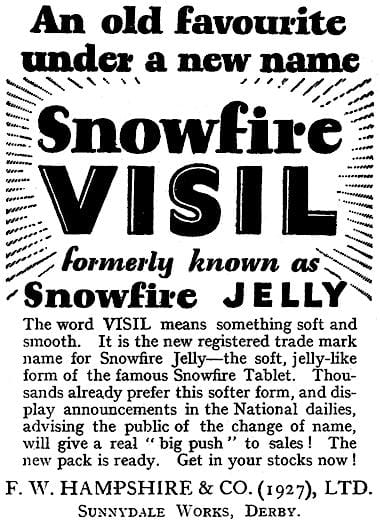
1930 Snowfire Visil.
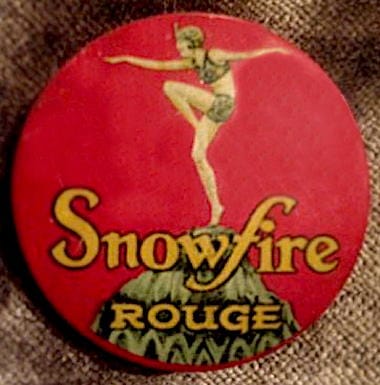
Snowfire Rouge container from the early 1930s.
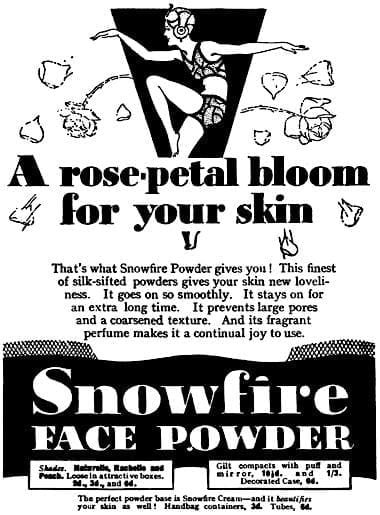
1932 Snowfire Face Powder. This image of a woman dancing appears to have been used on Snowfire packaging through to 1935.
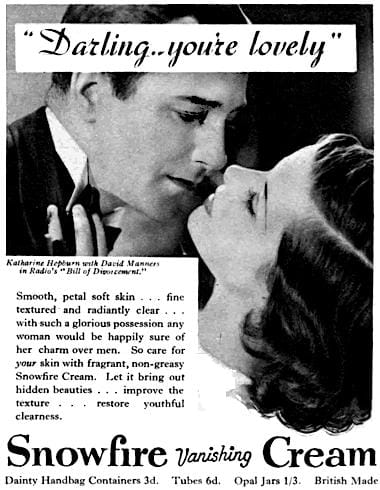
1934 Snowfire Vanishing Cream.
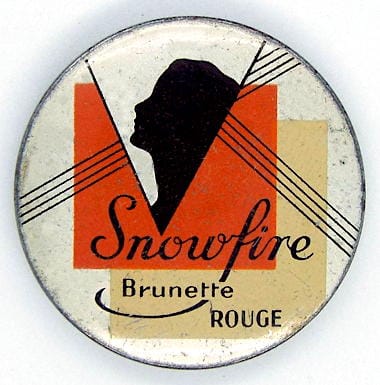
Snowfire Rouge container introduced in 1935.

1935 Snowfire Powder Cream.
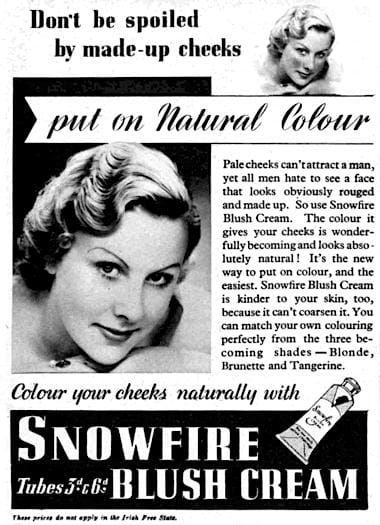
1937 Snowfire Blush Cream.
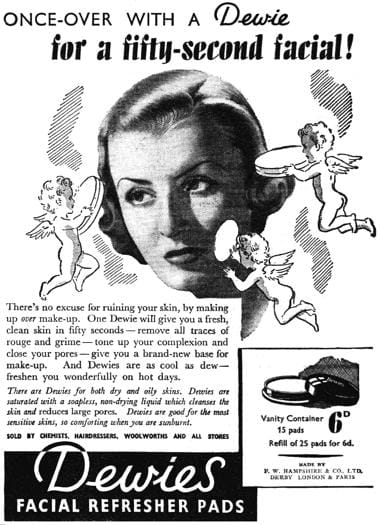
1939 Dewies Facial Refresher Pads.
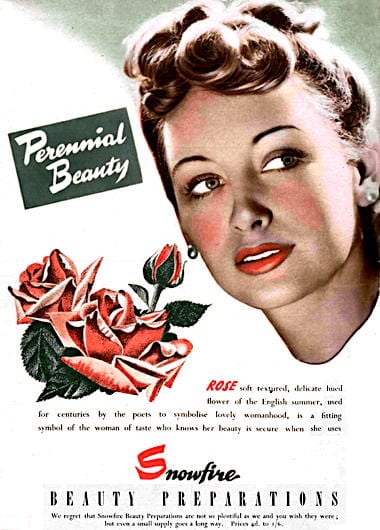
1941 Snowfire Beauty Preparations.
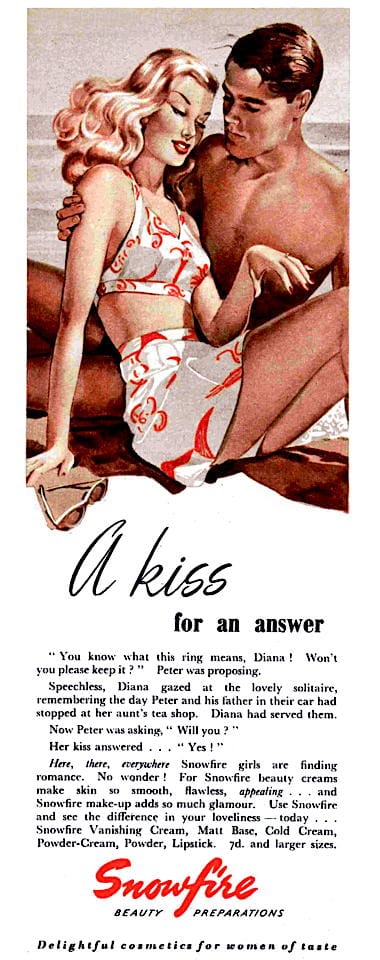
1948 Snowfire Beauty Preparations.
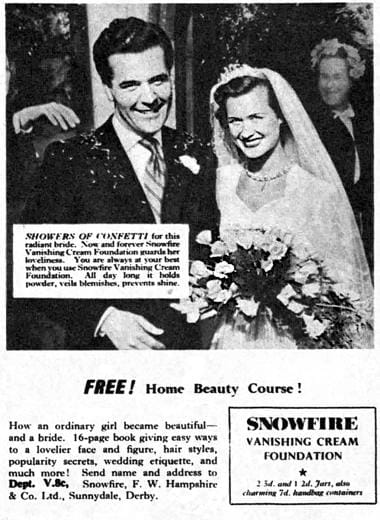
1950 Snowfire Vanishing Cream.

1950 Trade advertisment for Snowfire Face Powder, Vanishing Cream, and Powder Cream.

1951 Snowfire Face Powder.
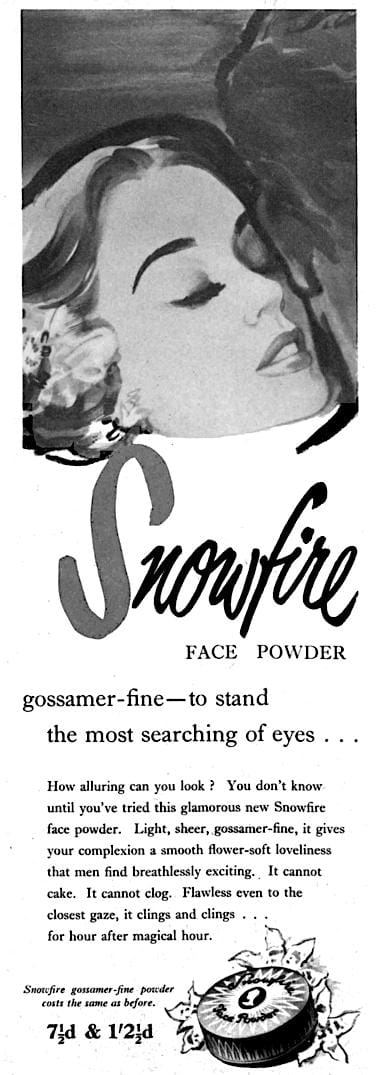
1954 Snowfire Face Powder in new packaging.
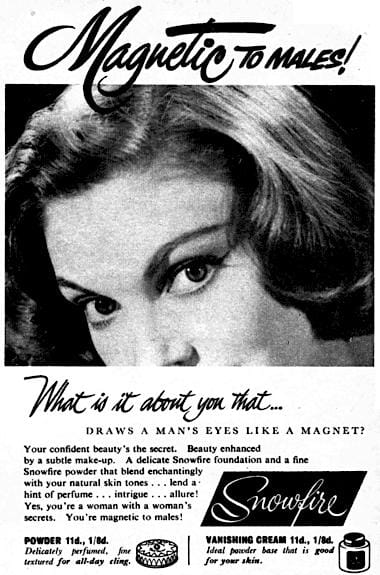
1957 Snowfire Vanishing Cream and Face Powder.
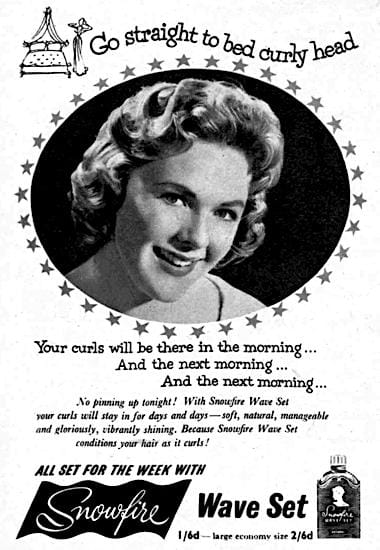
1957 Snowfire Wave Set.
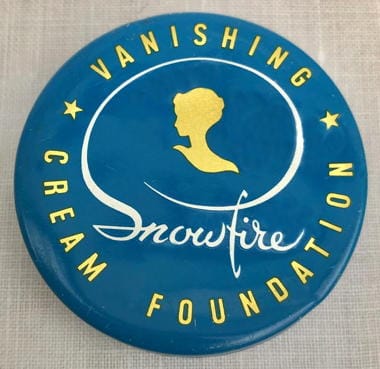
Snowfire Vanishing Cream in late 1950s packaging.
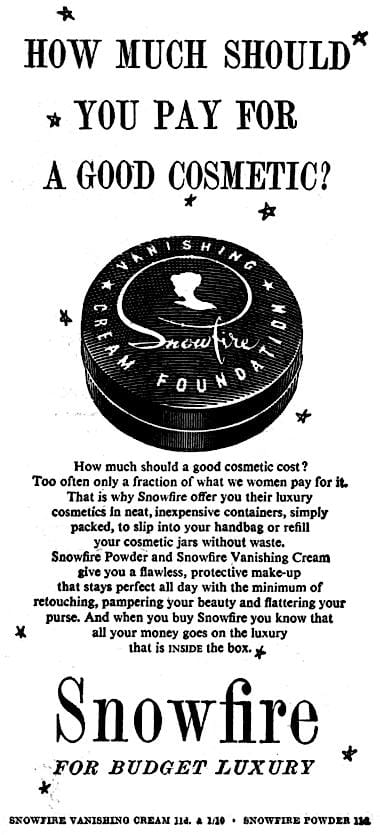
1958 Snowfire Vanishing Cream and Face Powder.
